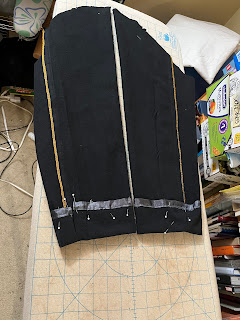Thanks to WandaVision, many more people have an idea what the Ship of Theseus is, and it's the best way I have of describing my version of the Paynter Jacket. How many changes can I make and still call it a Paynter?
I bought the pattern out of curiosity, I have been following the company and it's production/marketing strategy.
https://erniekdesigns.blogspot.com/2024/09/good-morning-paynter-field-jacket-link.html
I bought the pattern in September of last year. At the same time, I need a work jacket. that is something to hold my radio and my phone and some pens and a b7 notepad....and look like I belong where I am.
I looked at a lot of jackets and Chanel jackets and chef coats and the shackets that the caterers wear at the hall where I work..... and then looked at the Paynter that I was toiling to write a totally different piece about the Paynter Company and...Reader, I Made One.
This took forever, but that is thanks to a lot of days coming home from work and thinking "I don't need a jacket for a job I'm not going to have". I have a lot of "Don't Get Comfortable" vibes in my office, so my motivation to finish, much less begin, has been very very low.
I am always sewing. I have hemmed a billion t-shirts.
And I really changed up the program after the toile.
I did play with the bellows pocket. I played with the paper model (aka the pattern piece) and sewed it up and played with that as well. I worked on the Kelly anorak and that bellows pocket has a little offset stitching sauce that makes it easier to stitch.
Even so, goofing around with that took a month or so. This post is going to run on, so you might want to take a break too. Make a little batch of cilantro sauce.
My next thought was to try out an on-seam pocket in the front. I created a midline seam, and inserted a side-entry pocket bag into it.Not because I wanted the seam (it would be useful for FBA and SBA work, but I'm just a barrel shape now) as I wanted the unintended interior pocket this flap would create.
Chalk marked the seam line for stitching
You can see the lining side. I added binding to the top seam of the pocket bag. The far side of the bag will be caught in the stitching of the front facing, the bottom in the hem facing. It makes in interior pocket that will hold a radio or a phone in the other one.
Unfolded, this is the left interior.
I think it was the Helly Hansen rainslicker I discovered this on. I look for them in outerwear all the time. The Bathing Clown jacket from Sleepy Peach notes this as a feature.
I use my Uniqlo down cardigan a lot at work, sticking that radio in the interior 'pocket' and running the earpiece up through the neck. As much as I love those Uniqlo pieces for their utilitarian navy and black looks, they are lightweight pieces, made well enough, but they are not work wear.
A toile was made. Sewed it, marked adjustments. Added a back yoke to get a little reinforcement, a place for some lining to make putting it on a little slippier, and a tad more fabric in the back to cover my big beautiful butt.
Yes, I burrrito'd the yoke. It works; it's worth the effort. It is a very lot of fabric to roll up in a yoke, and if this were made of heavier fabric, it would not work. I'd still add a yoke shaped lining piece.
Progress. More time passes.
It was a straightforward make, two piece sleeve fit well, markings are good. There are a lot of nice details I left off (waist tabs not necessary), interior patch pockets with stitching that is covered by largeThe front placket instructions are hard to follow as written. The short version: make a paper model first. You make the placket and the buttonholes, you sew the placket at the hem and then fold it up and stitch it over the cover placket. This makes a significant lump at the hem, which you fold over and stitch through again - a total of seven layers. Yes, I had to count that several times. The Paynter Company must use some impressive machines to construct these jackets if they use anything resembling chore coat duck. My workaround was using the selvage edge of the fabric on the interior placket edges so I would not have to fold them under. There are no good photos of very black fabric being sewn to other very black fabric.
The struggle for me was recalculating that placket piece with my very much shorter jacket. You finish it, sew it at the bottom and fold it up to stitch it to the underside of the front edge facing. I finally ignored the buttonhole markings, chose my own, and went for it. I did enjoy better results because of the disembodied placket to stitch them on. Also no useful photos.
I have worn the jacket to work and still have a job. They are not related activities, however.
And now I need to fix the pants pattern. So I am making a second Paynter.

































No comments:
Post a Comment
Thanks for reading! I love your comments, I love your ideas, I love your recipes, but if you post links to advertising, I will delete your comment.